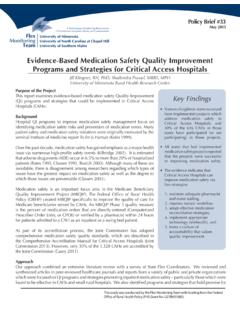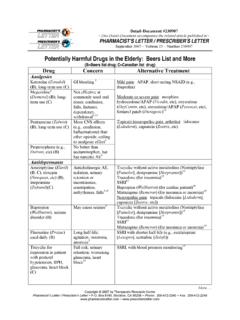Transcription of Reducing Potentially-Preventable Readmissions in …
1 INTRODUCTIONP reventable hospital Readmissions are considered to be a marker of poor-quality care and may reflect prob-lems with care coordination. Additionally, they place a significant financial burden on the health care Since October 1, 2012, the Centers for Medicare & Medicaid Services (CMS) has penalized Prospective Payment System (PPS) hospitals with excess readmis-sions by Reducing their Medicare payments under the Hospital Readmissions Reduction Program (HRRP) authorized by the Affordable Care Currently, Critical Access Hospitals (CAHs) are exempt from these penalties; however, readmission rates are an area of focus in the Medicare Beneficiary Quality Improve-ment Project (MBQIP).
2 It is important for CAHs to examine their readmission rates and consider imple-menting strategies to reduce Potentially-Preventable purpose of this project is to identify and dis-seminate information about successful evidence-based interventions that have been conducted to reduce Readmissions in CAHs and other small rural reviewed the literature on Readmissions , in-cluding articles in peer-reviewed healthcare journals, reports and websites from a variety of public and private organizations working on hospital readmis-sions. We sought to identify programs and strategies that have been successfully implemented in CAHs and other small rural hospitals, as well as other readmission prevention programs and strategies that hold promise for adoption in CAHs.
3 We reviewed information in the state Medicare Reducing Potentially-Preventable Readmissions in Critical Access HospitalsEmma Distel, BS; Michelle Casey, MS; Shailendra Prasad, MBBS, MPHU niversity of MinnesotaKEY FINDINGS It is important for Critical Access Hospitals (CAHs) to examine their readmission rates and consider implementing strategies to reduce Potentially-Preventable Readmissions . Several evidence-based readmission reduction programs that have been shown to reduce Readmissions in large hospitals are being implemented in CAHs or show promise to be useful in small rural hospital settings. Common readmission reduction strategies include increased time spent with patients and families at discharge to ensure that care management plans are understood and improving coordination with the patient s primary care physician.
4 A number of readmission reduction programs have shared their resources and tools with other programs, and make them available online. March 2016 Flex Monitoring TeamPolicy Brief # Performance Monitoring Resource for Critical Access Hospitals, States, and Communities2 Reducing Potentially-Preventable Readmissions in CAHsFlex Monitoring Team Policy Brief #43 | March Hospital Flexibility (Flex) Program work plans submitted for FY 2013 and 2014, and identified states with initiatives to reduce Readmissions . We interviewed Flex Coordinators in those states to ask about read-missions activities involving CAHs and how those activities were implemented. RESULTS Hospital readmission prevention initiatives identi-fied in the literature and through contacts with State Flex Programs include.
5 Project Re-Engineered Discharge (Project RED) Project BOOST (Better Outcomes for Older Adults through Safe Transitions) Care Transitions Program, University of Colorado Transitional Care Model SAFE Transitions of Care (Minnesota) Institute for Healthcare Improvement State Action on Avoidable Readmissions (STAAR) Agency for Healthcare Research & Quality s Guide to Reduce Medicaid Readmissions Preventing Avoidable Readmissions Together (PART, South Carolina) Reducing Avoidable Readmissions Effectively (RARE, Minnesota) Preventing Readmissions through Effective Partnerships (PREP, Illinois) Healthy Transitions and iCARE Programs (Colorado)This list contains both programs that have developed unique toolkits and initiatives that are using a combina-tion of toolkits from other programs to meet the unique challenges of Reducing Readmissions .
6 Project Re-engineered Discharge (Project RED) A national initiative supported by AHRQ, Project RED has been piloted in rural community hospitals and CAHs to decrease 30-day all-cause readmission rates. Project RED assigns a nurse discharge advocate to co-ordinate and follow-up with the patient post-discharge to facilitate patient understanding of their discharge The project also focuses on more direct involvement of the patient and family in the discharge process. Eighteen CAHs participating in the RARE Campaign chose to implement the RED curriculum in their hospital. Project RED has been implemented in a variety of rural settings.
7 In a 30-bed medical surgi-cal unit in a rural community hospital, implementation of Project Red over four months, 28 of 336 discharged patients ( ) were readmitted within 30 days (rep-resenting a 32% absolute reduction from the baseline readmission rate.)8 Project Better Outcomes by Optimizing Safe Transitions (BOOST)Project BOOST is a hospital discharge program that focuses on improving the hospital-to-home transition process for Medicare beneficiaries. It promotes eight key themes in its implementation plan to improve hos-pital discharge and transition: institutional support for the program, a steering committee, engagement of pa-tients and families, reliable data collection, specific and attainable goals, standardized discharge pathways, and policies & procedures within the institution to support the care In a study of academic and non-academ-ic hospitals over 12 months (11 hospitals implemented at least 2 BOOST tools; 19 control hospitals), BOOST reduced hospital Readmissions by a 2% absolute reduc-tion ( average readmission rate pre-Boost and average post-Boost).
8 10 The Illinois Hospital Association implemented components of the BOOST Toolkit in their Prevention readmission through Effective Partnerships (PREP) Thirty-one CAHs in Illinois that partici-pated in PREP implemented BOOST components. Using the BOOST tools, they worked to standardize discharge processes, improve care transitions, and re-duce Readmissions in their Transitions Program at the University of Colorado The Care Transitions program is a 4-week, evi-dence-based program developed at the University of Patients who participated in a randomized controlled trial at a large integrated delivery system ex-perienced lower rates of readmission than patients in the control group.
9 The readmission rates at 30-days 3 Reducing Potentially-Preventable Readmissions in CAHsFlex Monitoring Team Policy Brief #43 | March (n=379) for those in the intervention group and (n=371) for patients in the control During the program, patients and families work with a transitions coach to improve the hospital discharge and transition process through home visits and phone The patients learn self-management skills and work with their transition coach to set attainable goals for managing their Although the Care Transitions Program has been shown to reduce readmission rates in a variety of large-hospital settings, we were not able to identify any stud-ies testing the program in rural hospitals or CAHs.
10 This program was adopted by 17 CAHs in Minnesota that are participating in the RARE The CAHs used discharge advocates to help coordinate communi-cation between providers and to work with patients and their families to ensure they were ready for discharge. CAHs also had success utilizing home visits to ensure improved care Transitional Care ModelThe Transitional Care Model developed at the Uni-versity of Pennsylvania uses a transitional care nurse to act as a liaison between the patient and provider and coordinate transitions for the This model spe-cifically targets older adults with chronic disease. The nurse facilitates communication across different health-care settings and between the patient, family, and care The nurse makes home visits and telephone calls following discharge to ensure that the patient is receiv-ing necessary care.








